ON January 11 1992, Paul Simon kicked off his South Africa tour. He’d visited the country before, back in 1985 in defiance of the UN-sponsored cultural boycott against apartheid. On 2 December 1968, The UN General Assembly requested all States and organisations “to suspend cultural, educational, sporting and other exchanges with the racist regime and with organisations or institutions in South Africa which practice apartheid”. Sportsmen and music acts were encouraged not to play in South Africa.
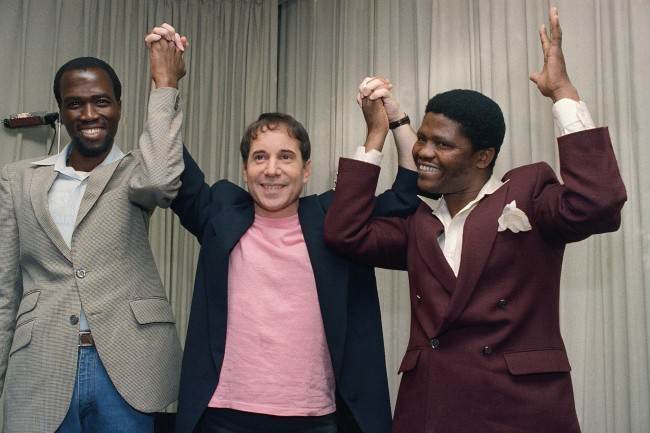
Singer-songwriter Paul Simon is joined by Albert Mazibuko, left, and Joseph Shabalala, right, at a news conference in New York, Aug. 25, 1986, to introduce Simon’s new album, “Graceland.” Mazibuko and Shabalala are two of the many South Africa musicians and singers who collaborated with Simon on his new album which blends the sounds of American pop music with that of black South Africa. (AP Photo/Marty Lederhandler)
The ANC and Artists Against Apartheid were outraged. Why hadn’t Simon consulted them before arriving?
Said Simon: “You went to South Africa but you didn’t ask us. You need to ask the ANC. So that’s the kind of government you’re going to be? Check our lyrics? F*** the artists like all kinds of governments have done in the past?”
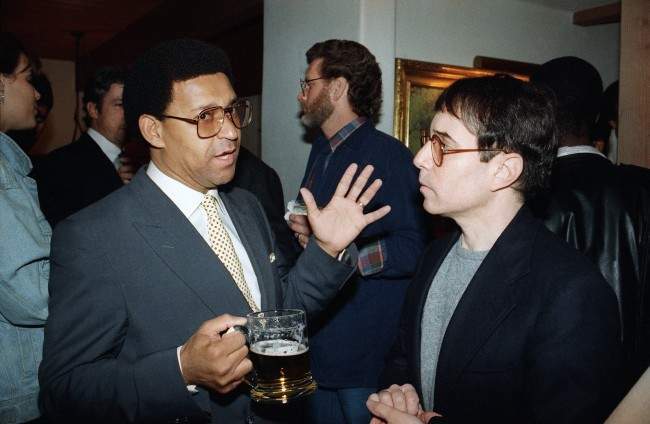
Rev. Allan Boesak of South Africa, left, meets with entertainer Paul Simon at the home of Jane Fonda and Tom Hayden in Santa Monica, Calif., March 10, 1987. (AP Photo/Mark Avery)
Simon’s foresight introduced much of the world to the music of black South Africa. That first trip led to his groundbreaking Graceland album, featuring South African musicians Hugh Masekela, Simon and Miriam Makeba and the Ladysmith Black Mambazo.
Joe Berlinger followed Simon on his trip. In his documentary Under African Skies, we hear Dali Tambo, founder of Artists Against Apartheid and son of the late African National Congress (ANC) president Oliver Tambo. He says: “At that moment in time, it was not helpful. We were fighting for our land, for our identity. We had a job to do, and it was a serious job. And we saw Paul Simon coming as a threat because it was not sanctioned by the liberation movement.”
Simon found it absurd that artists should be viewed in the light and shadows cast by politicians. Art, said Simon, would endure.
In 1987, Simon performed his Under African Skies Concert in Harare:
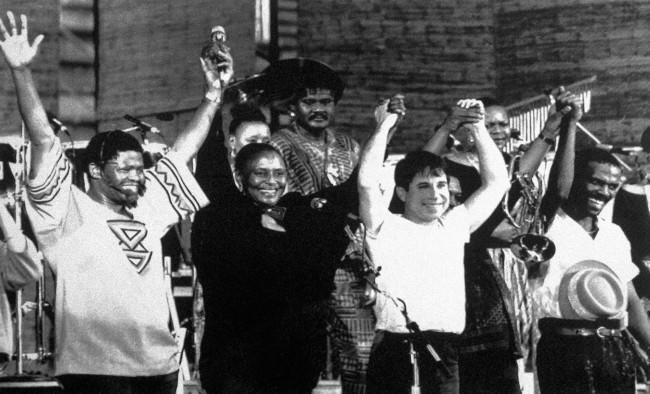
American pop star Paul Simon, second right, joins hands with South African musicians Joe Shabalala, left, Miriam Makeba, second left, who has been exiled for 27 years, and Ray Phiri, during the first day on a two-day concert entitled Graceland in Concert, in Harare, Zimbabwe on Feb. 14, 1987. Blacks and whites from as far away as New York, Nairobi and South Africa attended the concert, the first public performance in Africa of Simon whose latest songs blend African rhythms with American pop music. (AP Photo)

American singer Paul Simon performs for 20,000 fans in an open air stadium in Harare, Zimbabwe on Feb. 14, 1987, the first day of a two-day ÂGraceland in Concert event by Simon and 25 black South African musicians. It was Simon’s first public performance in Africa of his Graceland album which blends African rhythms with American pop music. (AP Photo)
When Simon returned in 1992, that boycott has been lifted. This time the ANC backed him.
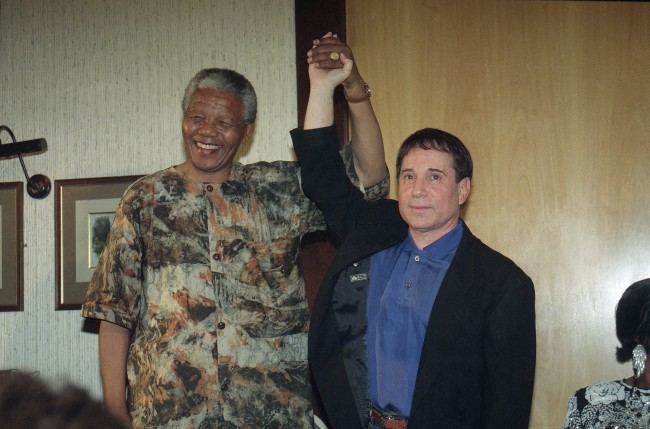
lson Mandela the president of African National Congress claps hands with American singer and songwriter Paul Simon in a gesture that signals the end of the boycott imposed by anti-Apartheid organizations, at a function held in Simon honour in Johannesburg, South Africa Friday, Jan. 10, 1992. (AP Photo/ Adil Bradlow)
Of the show in Johannesburg’s Ellis Park Stadium, The New York Times noted, “Most black South Africans could not afford to pay up to $30 for a ticket, or, lacking cars, to travel to Johannesburg from the outlying black townships.”
Entertainment Weekly surveyed the scene:
While Simon opened his two-week South Africa tour with such gentle songs as ”The Obvious Child,” ”Bridge Over Troubled Water,” and ”The Sounds of Silence,” armored police vehicles, bomb-sniffing canines, and even a surveillance helicopter patrolled the stadium. Outside, clusters of angry black protesters, representing leftist fringe groups that ferociously oppose the lifting of international sanctions against South Africa, were handing out leaflets, waving anti-Simon signs, and threatening to disrupt his concert with violence.
Not everyone could make it. One month earlier, Ladysmith Black Mambazo co-founder Headman Tshabalala had been shot dead by a white security guard. The guard had been arrested. He’d been released on $300 bail.
The day he arrived, two hand grenades exploded outside the offices of a Johannesburg company that helped arrange the tour. Complaints were also aimed at Whoopi Goldberg and the production of Sarafina!, which she is filming in South Africa.
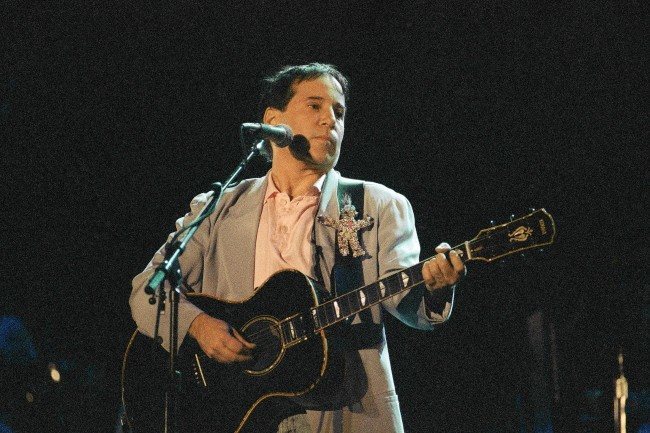
U.S. singer Paul Simon performs during his concert in Johannesburg, Jan. 11, 1992. Simon is the first international star to perform in South Africa since the lifting of the cultural boycott last year. A small group of black militants staged a demonstration outside the stadium. (AP Photo/Adil Bradlow)
The Baltimore Sun reviewed the show:
A small group of black activists, as many as 100 at one point, marched outside the entrance of Ellis Park Stadium in east Johannesburg with signs that said the singer had come at the wrong time with his “Born at the Right Time” tour.
The hand-lettered placards read: “Simon Go Home,” “Yankee Go Home,” “Don’t Delay Our Freedom,” and “Liberation First, Entertainment After.”
Members of a radical black group known as the Azanian Youth Organization had threatened to disrupt the concert with violence, saying that the American pop star was wrong to come to South Africa before the country’s political problems were solved.
“Artists should come after we have a democratic government,” said Kgomotse Modiselle, a 20-year-old high school student who described himself as a spokesman for the left-wing youth group. “Right now is not the right time for sanctions to be lifted.”
He said that only whites were attending the concert because blacks were opposed to Mr. Simon’s presence in South Africa. “The stadium is filled with white people,” he proclaimed.
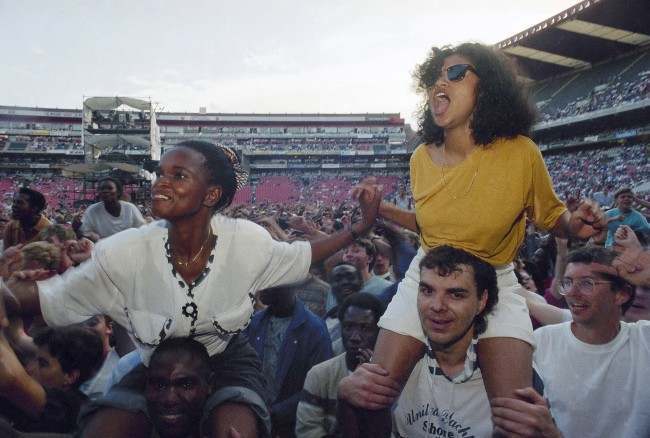
Fans at American singer Paul SimonÂs concert in the first of five concerts in Johannesburg, South Africa on Saturday, Jan. 11, 1992. The concert effectively marked the end of South Africa’s cultural boycott. (AP Photo/Adil Bradlow)
Violence was never far away.
About a half-dozen tanks painted in camouflage colors sat near the front of the stadium.
South Africa
Would you like to support Flashbak?
Please consider making a donation to our site. We don't want to rely on ads to bring you the best of visual culture. You can also support us by signing up to our Mailing List. And you can also follow us on Facebook, Instagram and Twitter. For great art and culture delivered to your door, visit our shop.






